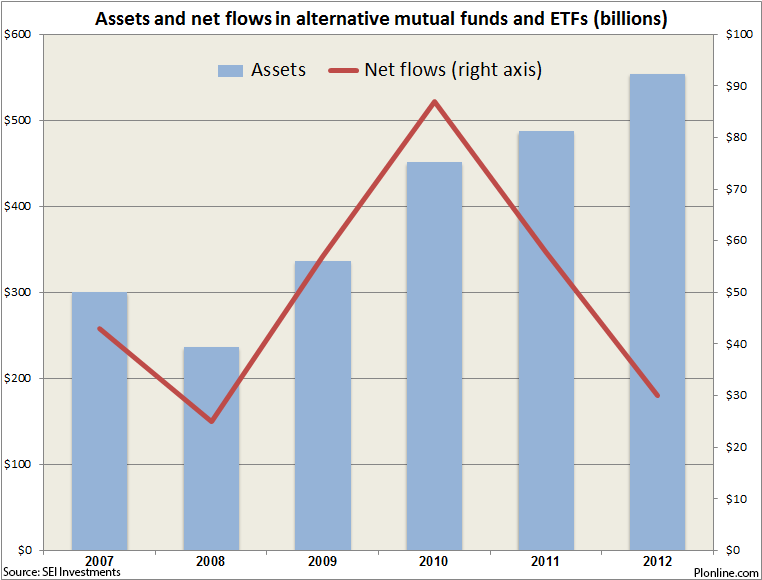Hedge world 4 Alternatives To Traditional Mutual Funds
Post on: 30 Март, 2015 No Comment

4 Alternatives To Traditional Mutual Funds
The first generation of mutual funds began to impress their existence
upon the public consciousness in the early 1970s. These open-ended
vehicles became widely used by both individual and institutional
investors to fund retirement plans, provide current income and
diversify small portfolios. But the 1990s saw the advent of several
new types of funds that were more streamlined, liquid and efficient
than traditional open-ended funds. This article explores several
reasons why the traditional open-ended mutual fund may be losing its
relevance. (For related reading, also check out _How To Pick A Good
Mutual Fund_.)
*TUTORIAL:* Mutual Fund Basics
*Cost Disadvantages*Although the first generation of mutual funds has
helped millions of Americans achieve their financial goals, they also
have several substantial disadvantages, such as high costs and
illiquidity. Many A-share mutual funds carry initial sales charges as
high as 5.75% and charge annual 12b-1 fees as high as 1%. B-shares
can have back-end sales charge schedules that gradually decline the
longer you hold your shares and C shares typically do not have initial
sales charges but can charge a back-end load if the shares are sold
within a short time frame. The latter two share classes also typically
have higher annual expenses than A shares. Obviously, this
substantially reduces the return on capital to the investor, both in
the short and the long term.
_Example_
John invests $100,000 in the A-share class of a growth fund. He pays
an initial sales charge of 4.75%, thus reducing his initial principal
to $95,250. The 12b-1 fees also reduce his average annual return of 8%
per year to 7.25%. If John leaves his money in the fund for 20 years,
the initial charge and lower annual return will reduce his overall
savings by nearly $80,000.
*Liquidity Disadvantages*Owners of open-ended mutual funds must also
wait until the settlement date to get their money out of the fund. An
investor who sells shares of a fund on Monday will not be able to take
constructive receipt of the sale proceeds until Thursday of the same
week, at the earliest. For investors who need to access their money
quickly for any reason, this can be a real problem.
*Forward Pricing*Mutual fund prices also lag the markets on a daily
basis. Because the portfolio managers trade securities within the
portfolio on a daily basis, it is impossible for open-ended funds to
post an intraday share price. They must instead use forward pricing,
which is based on the daily closing prices of all of the securities
within the portfolio.
*Performance Disadvantages*This is perhaps the greatest disadvantage
posed by open-ended funds. Although many funds have posted impressive
returns over five- and 10-year periods, the average annual returns of
virtually all stock funds have lagged those of the market itself over
longer periods of time. As of 2010, only one mutual fund that has
existed since 1970 has beaten the 10-year rolling return of the S&P
500 Index every single year. The rest have underperformed the markets
as a whole, which has led to the popularity of index funds that simply
invest directly in the S&P 500 or other index.
*Taxation Disadvantages*Although taxation of any type of investment
that is not housed inside a Roth IRA is inevitable, the taxation of
open-ended mutual funds is especially inevitable. Open-ended mutual
funds almost always pass on a pro-rata share of capital gains (and
losses) distributions to shareholders once each year, typically in
November. This means that any shareholder who owns shares in a taxable
account will have gains or losses to report every year. These gains or
losses may adversely affect the amount of income that the investor had
planned on reporting that year.
*Alternatives to Open-Ended Funds*Over the past 20 years, a plethora
of alternatives to open-ended funds have arisen. Although some of
these vehicles have become more popular than others, they all offer
diversification and some degree of professional management without
many of the shortcomings of open-ended funds. A list of these
includes:
*Unit Investment Trusts* *(UITs)*These instruments resemble mutual
funds in that each unit of the trust represents a portion of each
security that is held within the portfolio. However, they are more
tax-efficient than actively managed funds, although they may post
substantial gains or losses when the trust matures.
*Variable Annuity Subaccounts *These are essentially clones of
taxable retail funds, but must be treated and reported as separate
securities for regulatory reasons. Variable subaccounts have most
of the same disadvantages as open-ended funds except that they do
not post capital gains distributions.
*Closed-End Mutual Funds*
These funds have a limited number of shares than can be issued to
investors. Once all of the shares are sold, the fund is closed to new
investors and the shares begin trading in the secondary market.
* *Exchange-Traded Funds* *(ETFs)*Although this class of fund is
still the new kid on the block, ETFs have quickly become very
popular with serious investors for a number of reasons. As their
name implies, these funds trade like stocks on the major exchanges
and can be sold like any other security while the markets are
open. They provide liquidity, diversity and some degree of
professional management as well as tax efficiency in most cases.
They can be ideal instruments for tax-loss harvesting.
*Bottom Line*Although there is still a huge market for open-ended
mutual funds, their relative illiquidity, tax inefficiencies and
subpar performance compared to their benchmark indexes over time
have led to the creation of several more-efficient alternatives.
Instruments such as ETFs and UITs are rapidly increasing in
popularity and may eventually supplant their more traditional
cousins.
*by Mark P. Cussen*,CFP, CMFC
Mark P. Cussen has more than 15 years of experience in the financial
industry, which includes working with investments, insurance,














